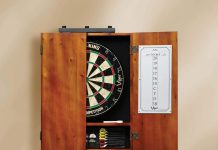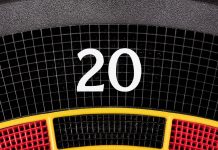Whether you’re a seasoned dart player or just starting out, having the right grip can make all the difference in your game. In this article, we’ll explore the world of dart grips and discuss how they can enhance your performance on the board. From understanding the different types of grips to finding the one that suits you best, we’ll provide valuable insights and tips to help you improve your game. So grab your darts and get ready to take your skills to the next level!
Review contents
Importance of Dart Grips
Dart grips play a crucial role in your game, as they directly impact your accuracy, control, and overall performance. Having the right dart grip can make a world of difference in your ability to consistently hit your target. It is important to understand the different types of dart grips, how they affect your game, and how to find the right grip that suits your playing style and preferences.
Different types of dart grips
There are various types of dart grips, each with its own unique advantages and disadvantages. Exploring these different grips can help you determine which one suits you the best. Here are some of the most common dart grips:
Front grip
The front grip, as the name suggests, involves holding the dart towards the front. This grip is ideal for players who rely on precision and accuracy. It allows for better control and stability, as well as easier release of the dart.
Middle grip
The middle grip involves holding the dart towards the middle, striking a balance between precision and power. Players who prefer a middle grip often enjoy the ease of transitioning between accuracy and strength when throwing the dart.
Rear grip
The rear grip involves holding the dart towards the back end. This grip offers more power and is favored by players who rely on a strong throw. It requires a high level of control to maintain accuracy while using this grip.
Hybrid grip
The hybrid grip combines elements of different grips, allowing players to customize their grip based on their preferences. This grip offers flexibility and can be adjusted to suit various playing styles.
Finger grip
The finger grip involves holding the dart primarily with the fingers. This grip allows for maximum control and precision, as the fingertips have a high level of sensitivity and dexterity.
Palm grip
The palm grip involves holding the dart in the palm of the hand, offering a more relaxed and comfortable hold. It provides stability and control, especially for players who prefer a looser grip.
Claw grip
The claw grip is characterized by a firm hold on the dart, resembling a claw shape. This grip offers a strong, stable grip and is popular among players who prioritize power and accuracy.
Pen grip
The pen grip involves holding the dart similar to holding a pen or pencil. This grip provides excellent control and precision, allowing for accurate and consistent throws.
Scissor grip
The scissor grip involves holding the dart between the thumb and forefinger, with the remaining fingers providing stability. This grip offers versatility and can be adjusted to accommodate different throwing styles.
Factors to Consider when Choosing Dart Grips
When selecting the right dart grip for your game, there are several factors to consider. These factors include grip size, grip material, texture, shape, and weight distribution.
Grip Size
The size of the grip is crucial as it directly affects comfort and control. A grip that is too small may feel unstable, while a grip that is too large might be difficult to hold securely. Finding the right balance in grip size is essential for achieving optimal performance.
Grip Material
The material of the grip can vary, with popular choices including rubber, nylon, or metal. Each material offers different levels of grip and texture. It is important to choose a material that feels comfortable and provides adequate grip for your playing style.
Texture
The texture of the grip can greatly impact your throwing motion. A smoother texture may lend itself to a more fluid release, while a more textured grip can provide increased friction and better control. Experimenting with different textures can help you find the right grip for your game.
Shape
The shape of the grip can vary from cylindrical to tapered. Some players may prefer a straighter grip for a consistent release, while others may prefer a more tapered grip for added control. Finding the shape that suits your hand and throwing style is essential for maximizing accuracy and control.
Weight Distribution
The weight distribution of the dart can significantly affect your grip and throwing motion. Some players may prefer a front-loaded dart for better control and accuracy, while others may prefer a more evenly distributed weight for a balanced throw. Consider experimenting with different weight distributions to find the one that feels most comfortable and effective for you.
How Dart Grips Impact Accuracy and Control
Having the right dart grip can greatly impact your accuracy and control during a game. Here are some ways in which dart grips can improve your overall performance:
Improving consistency
Using a grip that feels comfortable and natural allows for greater consistency in your throws. The more consistent your grip, the more likely you are to hit your target consistently, leading to improved accuracy over time. By finding a grip that suits your hand and playing style, you can develop muscle memory and execute your throws with precision.
Enhancing control
The right dart grip provides you with better control over your throws. It allows you to manipulate the dart’s flight path, adjust your release point, and fine-tune your aim. With a grip that offers good control, you can make precise adjustments mid-game, resulting in improved accuracy and higher scoring potential.
Reducing grip tension
Using the wrong or uncomfortable grip can lead to unnecessary tension in your hand and fingers. This tension can negatively affect your throws, causing jerky motions and decreased accuracy. A proper grip that feels natural and relaxed helps reduce grip tension, allowing for smoother and more controlled throws.
Common Gripping Techniques
There are several common gripping techniques that players use to hold the dart. These techniques can vary based on personal preference and playing style. Here are a few popular gripping techniques:
Three-point grip
The three-point grip involves holding the dart with three points of contact, typically using the thumb, forefinger, and middle finger. This grip provides a stable and controlled hold, allowing for precise throws.
Four-point grip
The four-point grip involves using all four fingers to hold the dart, with the thumb providing stability. This grip offers a secure and balanced hold, allowing for consistent and accurate throws.
Two-finger grip
The two-finger grip involves holding the dart with just the thumb and forefinger. This grip offers maximum control and precision, as it minimizes the points of contact with the dart.
Full hand grip
The full hand grip involves holding the dart with the entire hand, providing a relaxed and comfortable hold. While this grip may sacrifice some precision and control, it can be advantageous for players who prefer a looser grip.
Techniques to Improve Dart Grips
To improve your dart grip, consider incorporating these techniques into your practice routine:
Exercises for grip strength
To strengthen your grip, incorporate exercises such as squeezing stress balls, using grip trainers, or using grip-strengthening tools. These exercises help build the muscles and dexterity needed for a firm and controlled grip.
Practice drills for grip control
Performing drills that focus on grip control can help you become more comfortable and precise with your dart grip. Practice releasing the dart from different grips and distances, aiming for consistency and accuracy.
Grip maintenance and care
Properly maintaining and caring for your dart grips is important for ensuring their longevity and effectiveness. Clean your grips regularly, as dirt and debris can affect your grip and throwing motion. Additionally, regularly inspect your grips for any signs of wear or damage, replacing them if necessary.
Benefits of Using Finger Grips
Using finger grips can offer several benefits to your game. Here are some advantages of incorporating finger grips into your dart throwing technique:
Increased accuracy
Finger grips allow for precise control over the dart’s flight path, resulting in improved accuracy. The fingertips offer high sensitivity and dexterity, allowing for subtle adjustments mid-throw. Choosing a finger grip that suits your hand and playing style can greatly enhance your accuracy on the dartboard.
Better control and stability
With finger grips, you can achieve better control and stability over your throws. The fingers provide a secure and controlled hold on the dart, allowing for consistent release and follow-through. This improved control translates to more accurate and controlled throws, helping you hit your target consistently.
Reduced dart slippage
Finger grips offer a secure hold on the dart, greatly reducing the chances of the dart slipping or rotating unexpectedly upon release. This increased grip stability ensures a more consistent and predictable flight path for the dart, leading to greater accuracy and better scores.
Palm vs Finger Grips
Both palm and finger grips have their own advantages and disadvantages. Understanding these can help you make an informed decision about which grip to use:
Advantages and disadvantages of palm grips
Palm grips offer a relaxed and comfortable hold on the dart, reducing tension in the hand and fingers. They provide stability and control but may sacrifice some precision and sensitivity. Palm grips are favored by players who prioritize a looser grip and ease of release.
Advantages and disadvantages of finger grips
Finger grips offer maximum control and precision, as they allow for a secure and dexterous hold on the dart. They excel in providing accuracy, but may require more finger strength and control. Finger grips are favored by players who prioritize accuracy and consistency in their throws.
Choosing the right grip for you
Choosing between a palm grip and a finger grip ultimately comes down to personal preference and playing style. Experimenting with both grips can help you determine which one feels most comfortable and effective for your game. Remember, finding the right grip is a personal journey, so take the time to explore and test different options before settling on one.
Tips for Finding the Right Dart Grips
Finding the right dart grip is crucial for maximizing your performance on the dartboard. Here are some tips to help you find the grip that suits you the best:
Try different types of grips
Don’t be afraid to experiment with various types of dart grips. Explore different grip styles, materials, and textures to find the one that feels most natural and comfortable to you. Trying out different grips can also help you discover new techniques and improve your overall game.
Seek advice from experienced players
Seek guidance from experienced players who have mastered their dart grips. They can offer valuable insights and advice based on their own experiences. Take the time to observe their grips and techniques, and ask questions to gain a deeper understanding of different grip options.
Consider your playing style and preferences
Consider your playing style and preferences when choosing a dart grip. Are you more focused on accuracy or power? Do you prefer a lighter or heavier dart? Understanding your own preferences and style of play can guide you toward the grip that best suits your needs.
Common Mistakes to Avoid when Choosing Dart Grips
To ensure you make an informed decision when choosing your dart grips, avoid these common mistakes:
Choosing grips solely based on appearance
While aesthetics may be important to some players, choosing grips solely based on their appearance can be a mistake. Remember that comfort, control, and performance should be your primary considerations when selecting dart grips.
Ignoring grip comfort
If a grip feels uncomfortable or causes discomfort during practice or play, it is likely not the right grip for you. Ignoring grip comfort can result in decreased performance and potential risk of injury. Always prioritize comfort and make adjustments accordingly.
Not experimenting with different grips
Not giving yourself the opportunity to try different grips can limit your potential for improvement. Each grip offers different advantages and disadvantages, so it’s important to explore and experiment with a variety of options to find the grip that aligns with your unique playing style and preferences.
In conclusion, dart grips are an essential aspect of the game that can greatly impact your accuracy, control, and overall performance. Understanding the different types of grips, how they affect your game, and how to find the right grip for you is crucial for maximizing your potential on the dartboard. By incorporating the tips, techniques, and considerations mentioned in this article, you can improve your dart grips and elevate your game to the next level. So, grab your darts, experiment with different grips, and enjoy the journey of finding the perfect grip that will take your dart throwing skills to new heights.























![Best Outdoor Dartboards [Reviews and Buying Guide 2024] Best Outdoor Dartboards](https://gamersets.com/wp-content/uploads/2022/12/Best-Outdoor-Dartboards-100x70.jpg)

![Best Mini Air Hockey Table [Reviews & Buying Guide 2024] Best mini air hockey table](https://gamersets.com/wp-content/uploads/2022/10/Best-mini-air-hockey-table-100x70.jpg)







